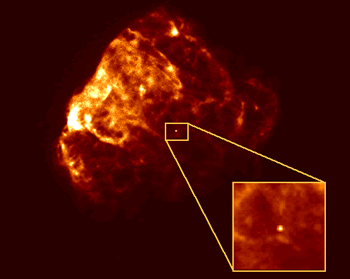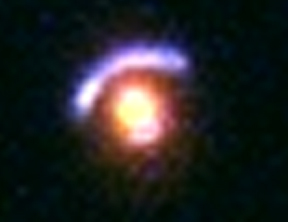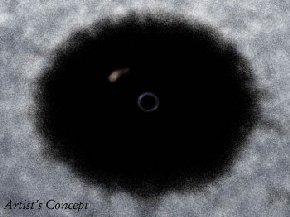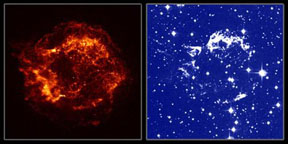The X-ray light image of the cloud Cassiopeia A versus the visible light image. If you look very closely, you can see a small bright spot near the middle of the cloud in the X-ray image. Scientists say this may be a neutron star or black hole.
Click on image for full size
Courtesy of NASA and the SAO Chandra X-ray Center
NASA Reveals First Images from Chandra
News story originally written on August 27, 1999
NASA revealed a few of the many images that will come from its newest telescope. Since first being deployed July 23, the Chandra X Observatory has had no problems. It first made a series of engine firings, before finally reaching its current orbit. The sunshade was opened, and now the images are starting to fly in.
The results are breathtaking. Included in the first set are images of a gigantic exploding star and a lightning quick X-ray blast flying through outer space. What's even more amazing, is the discovery of a possible neutron star or black hole found inside the stellar cloud.
NASA hopes this one discovery is just a glimpse of what's to come. They believe the powerful instrument will reveal black holes hiding throughout the universe. The Chandra takes images using X-rays instead of visual light. X-rays travel at a much higher frequency, and are usually released by extremely hot objects. Many of these objects cannot be seen with visual light, which means the Hubble Space Telescope cannot see them.
While the Hubble has a rather circular orbit close to Earth, Chandra follows an elliptical orbit, which sends the telescope to distances between 6,000 and 86,400 miles from Earth. It was named after a physicist, Subrahmanyan Chandrasekhar. He won a Nobel Prize in 1983.
You might also be interested in:

Neutron Stars are the end point of a massive star's life. When a really massive star runs out of nuclear fuel in its core the core begins to collapse under gravity. When the core collapses the entire star
...more
The NASA Hubble Space Telescope has recently found some awesome mirages produced by lenses in space. These lenses act as giant magnifying glasses for the Universe. A lens is produced when a large object
...more
Everyone is awed by black holes. How could there be a thing that just devours all light and matter around it...so that matter can never escape?!? Scientists using observations from the Chandra X-ray Observatory
...more
It was another exciting and frustrating year for the space science program. It seemed that every step forward led to one backwards. Either way, NASA led the way to a great century of discovery. Unfortunately,
...more
The Space Shuttle Discovery lifted off from Kennedy Space Center on October 29th at 2:19 p.m. EST. The weather was great as Discovery took 8 1/2 minutes to reach orbit. This was the United States' 123rd
...more
A moon was discovered orbiting the asteroid, Eugenia. This is only the second time in history that a satellite has been seen circling an asteroid. A special mirror allowed scientists to find the moon
...more
Will Russia ever put the service module for the International Space Station in space? NASA officials want an answer from the Russian government. The necessary service module is currently waiting to be
...more















